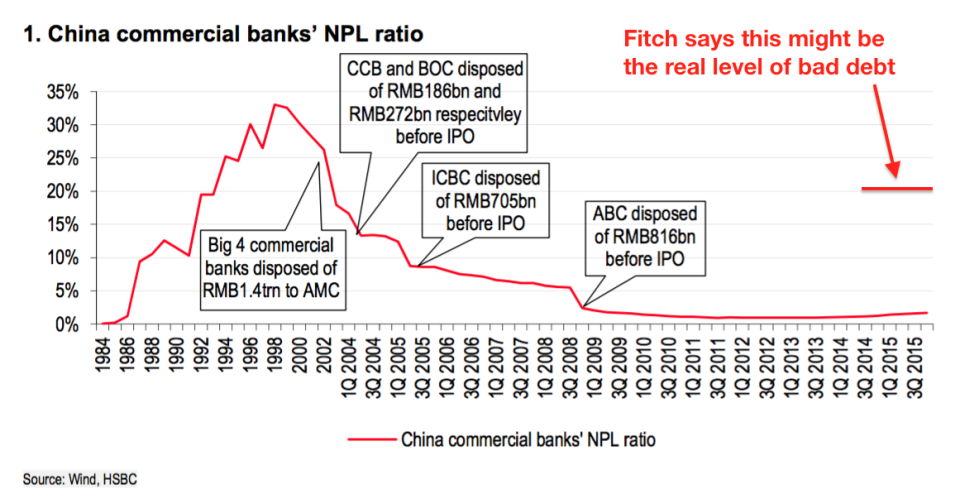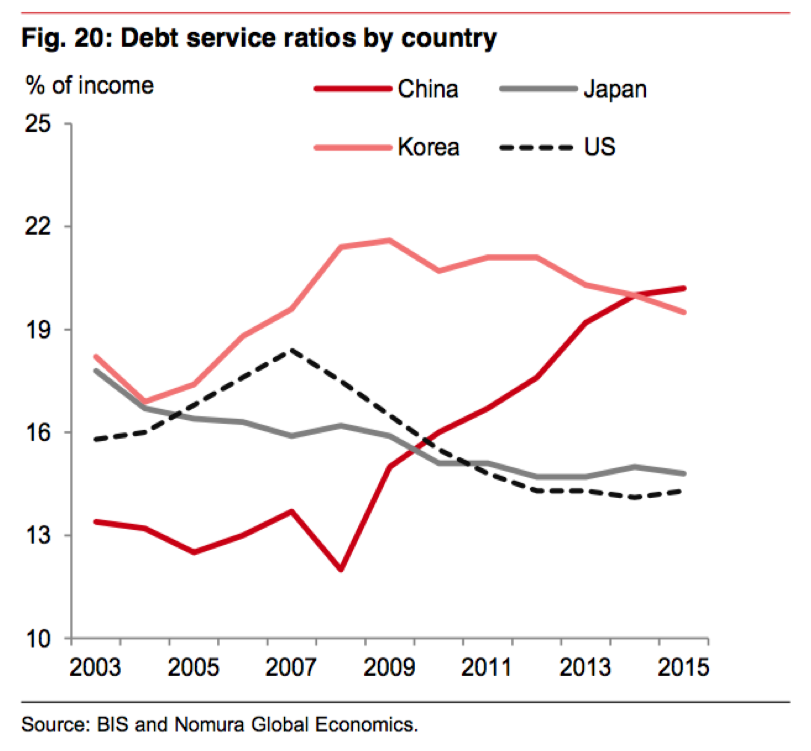China may have $2 trillion in hidden bad debt — 10 times more than official numbers report
The real level of bad debt in China might be 10 times the official number, according to the ratings agency Fitch. But don't worry! Fitch says that a "one-off resolution" of those non-performing loans (NPLs) would only cost $1 trillion. Or maybe $2 trillion.
To put that in perspective, here's a chart from HSBC showing the official level of NPLs. We have marked on the chart where Fitch thinks the real level sits:

HSBCFitch says China should be OK in the short-term, but "We think that sovereign resources will ultimately be needed to help address China's debt overhang," hence the $1 trillion to $2.1 trillion estimate.
There are two camps of thought on Chinese debt right now:
The "muddle-through" camp: Those who believe that while China's debt is growing, it remains in reasonable proportion to the size of its economy. The government is well-placed to manage defaults because it controls so many state-owned enterprises.
The crisis camp: Those who believe that China's debt is so massive, and the costs of servicing it so large, that it is now creating a drag on the economy as a whole. The Chinese finance system is political, non-transparent, and often corrupt. No one knows how damaging, or how sudden, Chinese debt defaults might be.
"NPL [non-performing loan] rates could already be as high as 15%-21% for the financial system. In contrast, official data showed the NPL ratio for commercial banks was just 1.8% at end-1H16. There seems a high likelihood that banks' NPL ratios will continue rising over the medium term, in light of this discrepancy. There are already signs of stress, most obviously in the increased frequency with which banks are writing off or offloading loans, such as those to asset-management companies.
"We estimate that a one-off resolution of the debt problem would currently result in a capital shortfall of CNY7.4trn-13.6trn (USD1.1trn-2.1trn) — equivalent to around 11%-20% of GDP."
Until recently, Chinese debt had mostly been a good thing. China's economy was growing faster than its debt, making the debt manageable. The growth also meant that there were positive returns on money loaned out to growing Chinese enterprises.
The problem with debt, however, is that it lasts a long time. As the debt pile grows, the repayments become larger and larger, placing a burden on the economy. Each renminbi of new credit loaned out produces diminishing results. That prompted Barclays analyst Ajay Rajadhyaksha to call Chinese debt a "bubble" earlier this year:

HSBCThis chart from Nomura shows that Chinese debt service costs are now the largest of four major economies:

HSBC"We think the Chinese authorities can still clear this debt," Mark Williams from Capital Economics told The Telegraph. "In an extreme scenario - with non-recoverable loans of 25% – we calculate that the government would have to spend a full 35% of GDP bailing out the banks. That would lift debt to 90%. That is high but in principle it is possible.”
"Possible." But not desirable. The sudden removal of 35% of Chinese GDP would be a catastrophe for the global economy.
NOW WATCH: Things are getting worse for Wells Fargo and now the FBI is getting involved
See Also:
There are 4 cities in China that show how the country has a dangerous property bubble
'Many clients have asked us for a Big Short-type trade regarding China'
China likes to stockpile crude oil whenever prices are at $50 or lower
SEE ALSO: One stat on the staggering scale of job losses in China
AND: Goldman Sachs note cites report that China's corporate debt is reaching the 'Ponzi stage'

 Yahoo Finance
Yahoo Finance 
